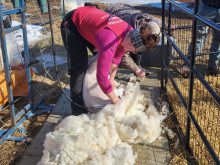RED DEER – Tom and Karolyn Stewart hoped this would be the year he
could quit his job in the oilfields and go farming full time.
Instead, drought and a feed shortage demanded he continue his off-farm
job to support his family of three children and his Charolais cow herd
in west-central Alberta.
“My goal was to quit the off-farm job this fall but with the year we’ve
had, I can’t,” Stewart said.
He was forced to make tough decisions this summer and fall and cull
Read Also

Charges laid after cattle theft
Saskatchewan RCMP lay two charges against a man after six cattle went missing.
heavily to pay for feed for the herd his father George started in 1960.
After spending $50,000 on feed, buyers had to be found to help pay the
mounting bills.
“I love farming and I love working with cattle, but we had to make a
choice,” he said.
The Maple Leaf Charolais herd was reduced to about 130 cows when 46
head were shipped to Mexico earlier this fall. Another 13 were
consigned to the annual full French Charolais sale held in Red Deer
Nov. 18.
Stewarts’ luck changed when John Rudiger of Calgary and a Mexican
consortium bid $11,100 for the ranch’s polled heifer. The sale’s high
seller, it is the first polled full French animal born in Canada.
The Stewarts have two more polled animals – a bull calf born this
November and a heifer born in the spring.
Full French Charolais haven’t been crossbred or upgraded to purebred
status. They can be traced directly back to herds purchased in France
in the early 1960s. All cattle are DNA parentage-typed to guarantee
they are full French.
A full French-style Charolais is shorter and stockier than the
made-in-Canada variety. They have a heavier hair coat and a more
noticeable dewlap. They are white or cream coloured. They also gain
well on less feed than some of the larger, rangier cattle.
New bloodlines are introduced through artificial insemination rather
than live imports.
George Stewart was among the early adopters of the big white cattle in
Canada, buying 21 through a contract buyer who travelled to France in
1965.
He had started a small herd in 1960 and when the opportunity to buy
cattle directly from Europe came along, he took the chance.
All the cattle in the Stewarts’ herd carry a distinctive maple leaf
brand on the left rib. Registered in 1886, the Stewarts bought the
brand when they switched from a dairy operation to Charolais in 1960.
Mexican cattle breeders look at Canada as a good source of full French
bloodlines, and groups of buyers have been coming to their farm since
1989.
“We haven’t advertised in years. They just come to your door,” George
said.
They have also exported two bulls to China.
This year’s third annual full French Charolais sale sold 57 lots for a
total of $108,375 and an average of $2,954. Another high seller was a
yearling bull consigned by Cave Full French Charolais of Bluffton,
Alta., which sold for $9,750.
Buyers came to the sale from Mexico, Illinois, Ontario, Manitoba and
Alberta.

















